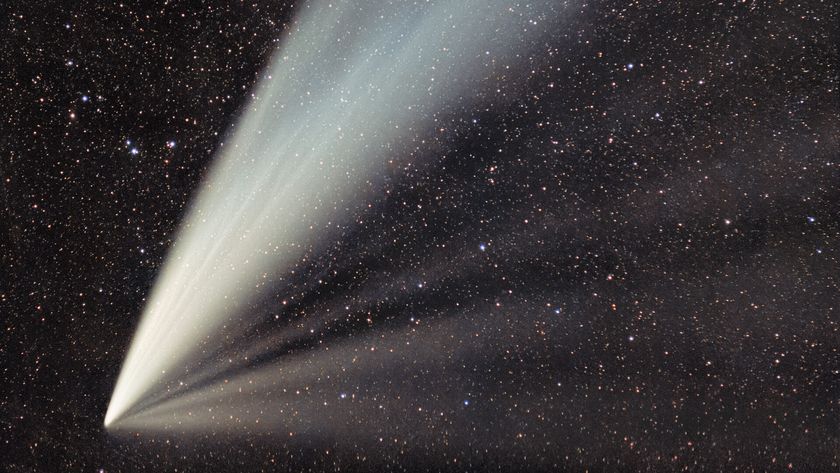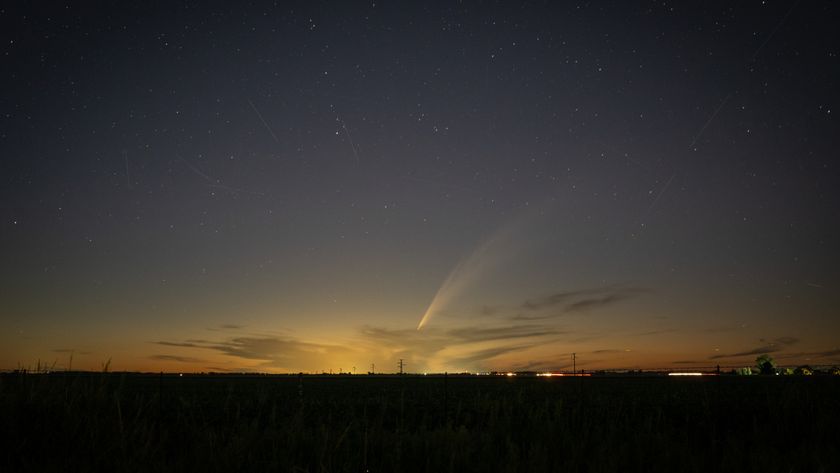Astronomers Imagine Comet's Birth
In the wee hours of our solar system, massive explosions on the sun might have sent free-floating gases whizzing at such high speeds that they embedded into tiny rock particles. These "rocklets" were then transported beyond Neptune and incorporated into a comet, researchers said today.
New research reveals surprisingly large amounts of the noble gases helium and neon in samples taken from comet Wild 2 (pronounced "Vilt 2"). The results, detailed in the Jan. 4 issue of the journal Science, suggest the gases came from a region very near the young sun, say the researchers.
Noble gases are a group of six elements that don't react with other elements. Since they are stable, noble gases are great "tracers" of chemicals from various parts of the solar system.
Preliminary examination of the comet samples, returned to Earth by NASA's Stardust mission in 2006, had revealed so-called igneous rock particles that only form under high-temperature conditions. On Earth, igneous rocks form when magma cools and solidifies, either after erupting from volcanoes or tucked beneath layers of earth.
So astronomers had previously concluded the particles that later got incorporated into Wild 2 formed very close to the sun, probably within the first million years of our solar system's history.
The new research "further characterizes the environment that they were in at the time they were formed," said study researcher Robert Pepin of the School of Physics and Astronomy at the University of Minnesota.
Odd-shaped blobs comprising a mix of dust grains and frozen gases, comets may be the oldest, most primitive bodies in the solar system. They hold the earliest record of material from the nebula that formed the sun and planets.
Sign up for the Live Science daily newsletter now
Get the world’s most fascinating discoveries delivered straight to your inbox.
While the grains in Wild 2 spent most of their lives in the frigid, distant reaches of the solar system, they were likely captured in "rocklets" that formed very close to the sun. Until recently, Wild 2 circled the sun in an orbit between Jupiter and Uranus, but in 1974 a close encounter with Jupiter sent the comet into an orbit that brings it closer to the sun.
What embedded the atoms of helium and neon into these rocklets? The researchers say intense radiation near the sun. "Not only was the environment hot, but it appeared to have been characterized by a lot of radiation which probably came from immense, early, magnetically driven solar flares very close to the sun," Pepin told SPACE.com.
The radiation, he explained, apparently accelerated particles of gases to such high speeds they embedded themselves into the little grains.
Even though the comet particles formed in the sun's neighborhood, the chemical makeup of the embedded noble gases looked nothing like solar material. Instead, the ratio of different forms of the helium and neon resembled that found in certain primitive meteorites, according to the researchers.
Jeanna Bryner is managing editor of Scientific American. Previously she was editor in chief of Live Science and, prior to that, an editor at Scholastic's Science World magazine. Bryner has an English degree from Salisbury University, a master's degree in biogeochemistry and environmental sciences from the University of Maryland and a graduate science journalism degree from New York University. She has worked as a biologist in Florida, where she monitored wetlands and did field surveys for endangered species, including the gorgeous Florida Scrub Jay. She also received an ocean sciences journalism fellowship from the Woods Hole Oceanographic Institution. She is a firm believer that science is for everyone and that just about everything can be viewed through the lens of science.













